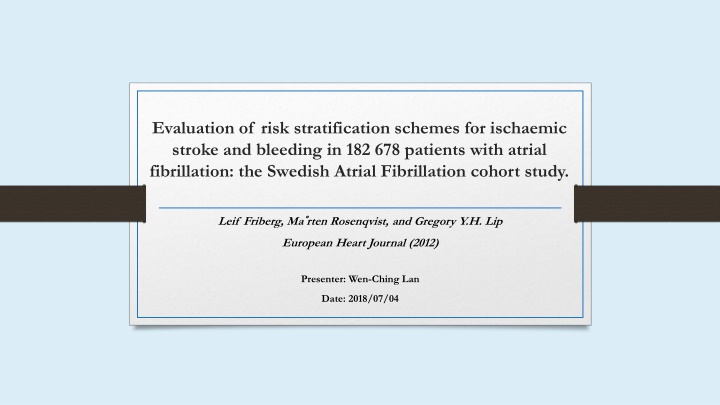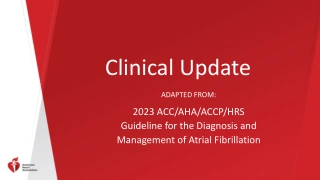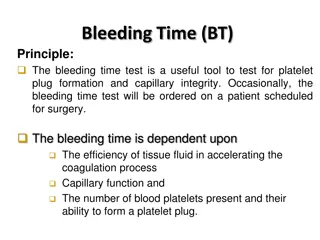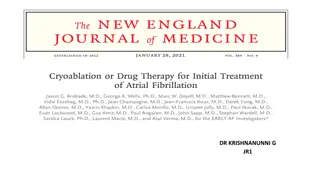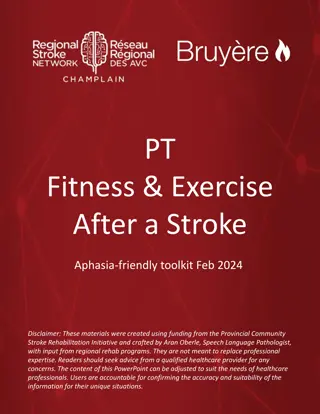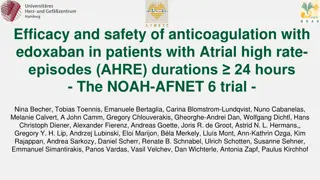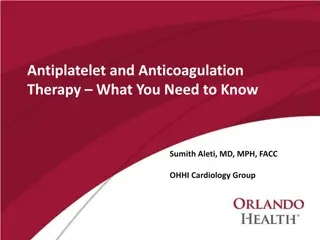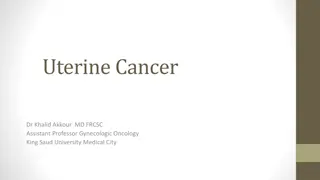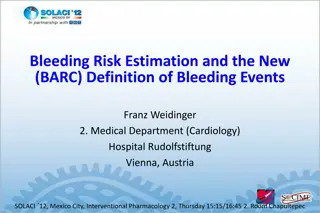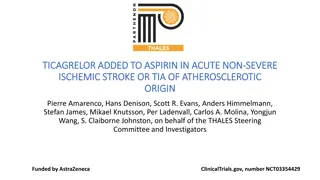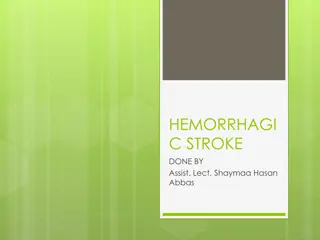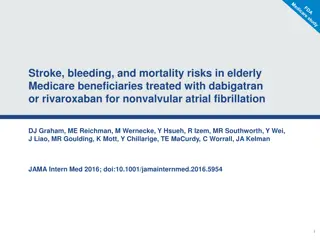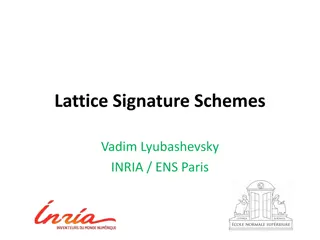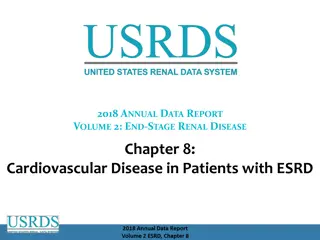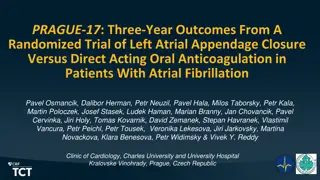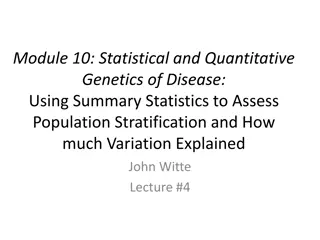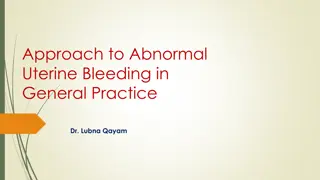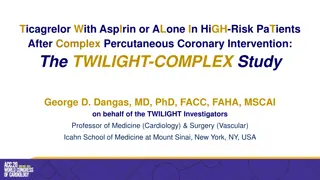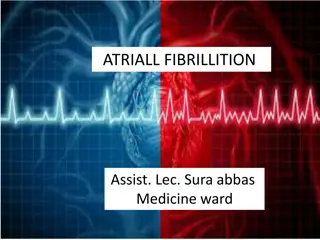Evaluation of Risk Stratification Schemes for Ischaemic Stroke and Bleeding in Atrial Fibrillation Patients
A study conducted in Sweden on 182,678 patients with atrial fibrillation aimed to investigate risk factors for stroke and bleeding. The research assessed the application of CHA2DS2-VASc and HAS-BLED schemes for stroke and bleeding risk evaluations. Data from the Swedish Atrial Fibrillation cohort study were used for the analysis, focusing on medication, endpoints of thromboembolism and bleeding, and the definition of stroke and bleeding risk schemes. The study aimed to enhance risk assessment in atrial fibrillation patients to improve treatment decisions.
Download Presentation

Please find below an Image/Link to download the presentation.
The content on the website is provided AS IS for your information and personal use only. It may not be sold, licensed, or shared on other websites without obtaining consent from the author.If you encounter any issues during the download, it is possible that the publisher has removed the file from their server.
You are allowed to download the files provided on this website for personal or commercial use, subject to the condition that they are used lawfully. All files are the property of their respective owners.
The content on the website is provided AS IS for your information and personal use only. It may not be sold, licensed, or shared on other websites without obtaining consent from the author.
E N D
Presentation Transcript
Evaluation of risk stratification schemes for ischaemic stroke and bleeding in 182 678 patients with atrial fibrillation: the Swedish Atrial Fibrillation cohort study. Leif Friberg, Ma rten Rosenqvist, and Gregory Y.H. Lip European Heart Journal (2012) Presenter: Wen-Ching Lan Date: 2018/07/04
Introduction Atrial fibrillation (AF) is associated with a substantial risk of stroke and thromboembolism. The ESC guidelines recommend the use of the new CHA2DS2-VASc scheme to allow a more comprehensive stroke risk assessment, and to improve our ability to predict the truly low risk subjects with AF, who may not even need antithrombotic therapy.
AIM Our objective was to investigate risk factors for stroke and bleeding in AF, and application of the new CHA2DS2-VASc and HAS-BLED schemes for stroke and bleeding risk assessments, respectively.
Methods We used the Swedish Atrial Fibrillation cohort study, a nationwide cohort study of 182 678 subjects with a diagnosis of AF at any Swedish hospital between 1 July 2005 and 31 December 2008. Medication at baseline was defined as a drug that had been collected at a pharmacy within +-3 months of the index date.
Methods Warfarin is the only registered oral anticoagulant in Sweden, with a minority of patients using Marcoumar. The index date was defined as the date of the first occurrence of the patient with a diagnosis of AF (ICD-10 code I489) after 1 July 2005. We applied a blanking period of 14 days after index.
Methods Endpoints We relied on diagnoses given at hospital discharge. For the endpoints of thromboembolism, we used ischaemic stroke (ICD-10 code I63), and a composite thromboembolism endpoint of ischaemic stroke, unspecified stroke, TIA, and systemic embolism (I63 64, G45, I74). The primary bleeding endpoint of interest was intracranial haemorrhage (ICH) (I60 62) (see Supplementary material online, Table S2 for the specific ICD-codes used)
Methods Definition of stroke and bleeding risk schemes AFI Investigators, SPAF, ACC/AHA/ESC guidelines, Framingham, NICE score 0 7:low, 8 15: intermediate, 16 31: high risk
CHADS2 Score CHA2DS2VASc Score , 2012
Methods Statistical methods Multivariable Cox regression Multivariable analyses The net reclassification improvement (NRI) from switching from older risk stratification schemes to CHA2DS2-VASc. All analyses were performed in PASW 18.0 (SPSS)
Discussion This is the largest published real world data set of prospectively collected nation-wide cohort data on AF patients in relation to stroke and bleeding outcomes. A marginally better performance for CHA2DS2-VASc over CHADS2 for the composite thromboembolism endpoint, and confirming that a CHA2DS2-VASc score 0 is truly low risk . We extend previous studies by separately relating HAS-BLED and HEMORR2HAGES to ICH and major bleeding events and show that the predictive ability with both bleeding risk schema were similar.
Discussion Limitations The main limitations for studying stroke prediction rules in contemporary cohorts of AF patients not on warfarin are the major selection bias for which it can only be partly adjusted. Our lack of data on anticoagulation control (e.g. time in therapeutic range, TTR). We had incomplete data on NSAID use and genetic factors. Another possible limitation is the underreporting of some comorbidities, especially hypertension.
Conclusion Several independent risk factors (prior ICH, myocardial infarction, vascular disease, and renal failure) predict ischaemic stroke and/or the composite thromboembolism endpoint in AF, but thyroid disease (or hyperthyroidism) was not an independent risk factor for stroke. There is a better performance for CHA2DS2-VASc over CHADS2 schemes for the composite thromboembolism endpoint. While both tested bleeding risk schemes have similar predictive value, the HAS-BLED score has the advantage of simplicity.
